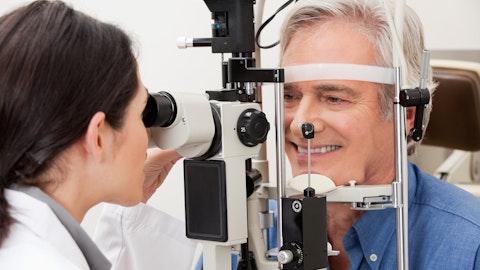Thomas W. Burns: Yeah. So, Allen, thanks for the question. So you’re right. We do expect iDose to be accretive in to our gross margin over time. And to your second point, for now we caution you with some conservatism as there could be some modest volatility in the margin as we ramp up iDose and go through a new product launch and the associated scaling that happens from a manufacturing standpoint. But that said, we expect the overall probably 2024 gross margin to land in that upper end of what we’ve always said was an 83% to 84% range. So we’re thinking probably plus or minus 84% for the year.
Operator: We’ll move next to Joanne Wuensch at Citi.
Joanne Wuensch: Thank you very much for taking the question. Two. One has to do also with the expense side of the income statement. Since you’re investing so much in not just research and development, but also in launching multiple new products. How do we think about operating expenses for 2024? And I’ll toss my second question on at the same time. One of the things I’m trying to figure out is how physicians are going to be spending their time. Do you think of the iDose launch as maybe cannibalizing more traditional MIGS procedures, complementary? Or how do we think about, how the physician spends his or her time having, now multiple types of products to use? Thanks.
Alex R. Thurman: You bet. Hey, Joanne. This is Alex. I’ll start with your OpEx question. So I think the way to think about 2024 is to expect that both to your point, both SG&A and R&D will grow in this year as we continue to invest in our iDose launch and the pipeline. The way I would counsel you to think about it is to start with our baseline 2023 adjusted operating expenses, which excludes the IP R&D and that number was about $360 million. And then I would assume about a 10% growth up to that base. So that would apply 2024 OpEx just shy of about $400 million for the year.
Joseph E. Gilliam: And then as it relates to iDose and the sort of overall procedure dynamics within the Glaukos framework, I think the right way to answer that is to look at it both over the short and the longer term. Certainly over the short term as we’re driving training and initial launch, I don’t expect it to have a significant impact, to obviously the dynamics within the practice and how they handle their time between, traditional MIGS products and the new class of procedural pharmaceuticals. Certainly, as we move forward, you can expect that with success, I think iDose likely will cannibalize to a certain extent some of those, traditional mixed procedures that surgeons get more and more confident in utilizing the product and the reimbursement associated with the etcetera and utilize it, whether it’s a standalone product or in combination with cataract surgery or in combination with other procedures, as Tom mentioned earlier, depending upon the needs of the individual patient.
But over the long term, our expectation is that iDose really becomes the cornerstone of the interventional glaucoma paradigm that we’ve talked about in the past. And we would expect more and more practices both through the investment of new surgeons as well as shifting of their own allocation of time for them to be spending more and more time treating glaucoma patients with minimally invasive solutions just like iDose and others. And we put forward and we are putting forward a significant amount of investment to drive that change in the standard of care over the course of many years as we move forward here.
Joanne Wuensch: Thank you.
Operator: Our next question comes from David Saxon at Needham and Company.
David Saxon: Great. Good afternoon. Thanks for taking my questions. Maybe I’ll start on the US Glaucoma sales force. Are you doing anything to compensation or incentives to ensure there’s a focus on the iDose launch, but to also make sure they’re not forgetting, like inject, infinite, etcetera, so the rest of the US business doesn’t, kind of stall out?
Joseph E. Gilliam: Yes, David. Well, the short answer is yes. And clearly, we’ve got a pretty well-structured strategy as it comes to compensation both as it relates to new product launches as well as existing business. We’re deploying that here. It’s absolutely an art, not a science when it comes to doing that, but we think we’ve got the right balance of continuing to drive, really three things. First is, as you referenced, the iDose launch and activities around that. Second, the other areas of the business in terms of revenue generation whether that be iStent inject or certainly iStent infinite as we continue to drive that forward. And third, really incentivizing the kind of behaviour to support what I just answered in the last call, which is putting in place those foundational building blocks and driving the activities that we think will expand the market, over the next several years and certainly the next decade as we think about what’s going to really matter to drive in this business, not just in 2024, but far beyond.
David Saxon: Great. That’s helpful. And then, just on the pipeline, looking at iLution, so phase 2a, started in the fourth quarter, what are the milestones this year, for that pipeline product and what’s a reasonable expectation for when that could be commercial? Thanks so much.
Thomas W. Burns: Yes, David. I’ll be answering the first part of your question. We’re going to be looking at assessing completing and assessing that clinical trial for iLution Travoprost this year, and we expect to be able to have data in hand by the end of this year. And when we see that data, we’ll then make determinations on how we go forward into a potential Phase 3. So I can’t ask the second part of your question, but I can tell you that we’re excited about iLution both with Travoprost and then you’ve seen the data as well of iLution and the use of dry eye where we saw substantial changes in visual acuity as well as substantial improvements in tear film stability. So these are two leading candidates and APIs for this new platform that we hope will be a significant contributor for us in the future.
David Saxon: Great. Thanks so much.
Operator: We’ll move next to Anthony Petrone at Mizuho Group. And, Anthony, your line is open. You may have yourself muted. Hearing no response, we’ll move next to Sam Brodovsky at Truist Securities.
Sam Brodovsky: Hey. Can you hear me okay?
Thomas W. Burns: Yes. We can.
Sam Brodovsky: Great. Thanks for taking the question. I’ll just squeeze two quick ones in on iDose. Just I think you had mentioned second half assumption for the J-Code for the permanent. Can I nail you down on whether the guidance assumes July 1 or October 1? And then on the ASP, any incremental color on what the realized ASP is going to be and how much we can expect in terms of gross to net or a discount there?
Joseph E. Gilliam: Yes, sure, Sam. It’s Joe. I think maybe to put a little bit more color just in terms of the technical dates that were behind what Tom suggested. By putting in that application, prior to the end of the year, you would assume that the CMS cycle would deliver a J-Code starting July 1. That also then translates into, reported ASPs by the fourth quarter, both of which each of those are incremental drivers in terms of creating a seamless, call it market access or reimbursement environment around that that J-Code and overall iDose. As you think about, really the broader dynamic around the iDose launch, those things are going to be real key drivers as we’ve talked about alongside the training initiatives and the things that are there to unlock, if you will, the iDose opportunity as we move forward.
And, and I know you had a second question as well. Gross to net. Yeah. So as we’ve talked about, we will not be doing, rebating associated with the iDose product. But where you will see that is obviously in government related programs where there’s standard discounts. And so over time, a portion of our revenues, we realize that, that 23% discount that’s typical with government related programs. So I think it’s probably fair to say this will that we’ll keep you apprised as we move forward that, realized ASP somewhere in the $13,000 range is probably a safe place to start from a modeling perspective, and we’ll dial that in over time as our mix becomes more clear.
Sam Brodovsky: Great. Thanks for taking the questions.
Operator: And at this time, that does conclude the question-and-answer session. I would like to turn the conference back over to management for closing remarks.
Thomas W. Burns: Okay. I want to thank you all for your time and attention today. And we also thank you for your continued interest and support of Glaukos. Goodbye.
Operator: This concludes today’s conference call. Thank you for your participation. You may now disconnect.
Follow Glaukos Corp (NYSE:GKOS)
Follow Glaukos Corp (NYSE:GKOS)
Receive real-time insider trading and news alerts


